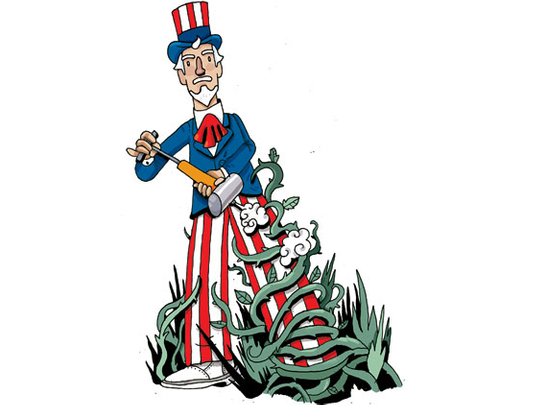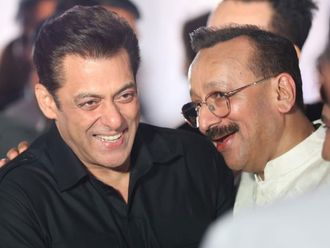
When the United States decided to invade Afghanistan in October 2001 following the Al Qaida sponsored 9/11 attack on its soil, it was an American war being waged against the Taliban regime which was harbouring Al Qaida. Until then Al Qaida targets of terror attacks were focused primarily on America and its interests worldwide.
Other western states got drawn in the conflict when their forces under the umbrella of Nato became a part of the offensive. Pakistan became an unwilling coalition partner as it found itself caught in a severe bind because the only viable access to Afghanistan for the US military juggernaut was through its air and land spaces.
US demand for access was allegedly conveyed by the US president to his Pakistani counterpart in the following blunt words, "Either you are with us or against us, and if you are against us, be prepared to be bombed to the stone ages." Pakistan had little option but to concede to the US ultimatum, and was sucked into somebody else's long drawn war which it could ill afford.
In a fast paced campaign where air power was employed on a massive scale, the Taliban were routed within three weeks. Pakistan had urged the Americans to ensure that having ousted the Taliban regime they should replace it with a government in Afghanistan where all ethnic groups are proportionately represented, rather than handing over power to any minority faction. Unfortunately this sound advice was ignored by the Americans and a government comprising the Northern Alliance tribes where the majority Pashtuns were barely represented was installed.
The defeated Taliban leadership and foot soldiers were not destroyed and they melted away and took refuge among their Pakistani Pashtun clansmen across the Durand Line. By disenfranchising the majority Pashtun population in the running of the affairs of the state, the seeds for a popular revolt were sown and the sympathy for the ousted Taliban in the Pashtun belts of Afghanistan and Pakistan gained momentum.
When the focus of the US shifted from Afghanistan to Iraq in 2003, the Taliban after recuperating and regrouping in Pakistan's Federally Administered Tribal Areas (FATA) started a campaign to regain power in Afghanistan.
A series of strategic blunders by the US and its allies have changed the complexion of the war, where now the Taliban factions rather than Al Qaida have emerged as the major threat to world peace. Terror attacks by Taliban are not confined to Afghanistan and Pakistan but are being planned and executed worldwide.
A comprehensive plan to neutralise the Taliban threat must, therefore, be accorded the highest priority by the international community. Use of excessive military force without other effective strands of strategy has not worked so far and is unlikely to work in the future. In fact it has made the situation worse as the ranks of Taliban continue to swell with volunteers joining the group from within and outside the Pashtun population. While the onus of military actions lie with ISAF and the Pakistani armed forces, other nations, particularly the Gulf Cooperation Council (GCC) can help implement other strands of the strategy to combat the Taliban menace.
There is a need to minutely examine the nature and characteristics of the tribal regions and learn about their tribal structure. This will assist in weaning away the tribesmen from their current propensity to joining the Taliban syndicate.
A cursory study of the tribal structure in the region will reveal three elements within the tribe who are vulnerable to the influence of the Taliban.
First, those who have been threatened by the Taliban and are forced to provide finances and/or their grownup sons to fight for the Taliban.
The second group comprises the poor Taliban for whom joining the ranks of Taliban may be their only means of sustenance, and finally there will be elements on the fringes of the tribal hierarchy who have been marginalised and have a low status. A comprehensive plan must be developed and implemented to remove the factors that make the three elements vulnerable to the Taliban recruitment drive.
The tribal structure in the Pashtun belts over the last decade has weakened considerably and the religious scholars have taken over the tribal leadership. This process needs to be reversed by strengthening the age old tribal structure. This can be only achieved through proper intelligence, an area where GCC countries excel.
Weakening of the hold of the half-literate fanatic religious mullahs and empowering the real tribal elders would be the first step in altering the current mindset of the Pashtun tribesmen and the eventual defeat of the Taliban movement.
The US administration has authorised the creation of ‘opportunity zones' for economic development in Pakistan's tribal belts bordering Afghanistan.
In addition the Pakistani government has recently promulgated a FATA Sustained Development Plan, to be implemented over nine years at a cost of $2.06 billion (Dh7.5 billion).
GCC assistance
If the tribal structure is restored through a proper study in collaboration with the GCC countries and additional funds are put in by the Gulf States and these are spent through active involvement and participation of the tribal elders and their genuine leadership, it will help promote literacy, alleviate poverty and backwardness from the area thereby reducing the influence of the Taliban ideology. Conducting such studies in Taliban strongholds may not be possible at this point in time but a start can be made first from the settled areas of the Khyber Pukhtoonkhwa (earlier NWFP) province.
The last five years have seen an increase in sophistication of the use of explosives and terror tactics by the Taliban. They appear to have adopted much of the techniques and tactics that the Iraqi insurgents had very successfully employed in Iraq. Improvised Explosive Devices (IEDs) that use sophisticated materials to manufacture explosives that are powerful, difficult to detect and employ remote controlled detonation methods were not a part of the Taliban armoury some years ago but have now become a regular feature.
Who is providing the Taliban the arms and sophisticated explosives? Perhaps the arms are being provided by the arms merchants of the former Soviet Union, the funds are generated through large and petty crimes and drug trafficking while the sophisticated explosives are coming courtesy the groups responsible for the Iraq insurgency.
Given that some of the Iraqi insurgents had close ties with Iran, is it possible the supply is coming from the Iranian black market? The Taliban is a fanatical religious group that adhere to the Deobandi School of Sunni fiqh whereas Iran is a Shiite theocracy and each considers the other as heretic. Are they colluding with each other under the maxim ‘the enemy of my enemy is a friend,' considering that both consider the US as their number one foe? The international community must find answers to these riddles to help it crush and neutralise the Taliban threat.
- Dr Mansour Bin Tahnoun Al Nahyan lectures in political Science at the American University of Sharjah.








